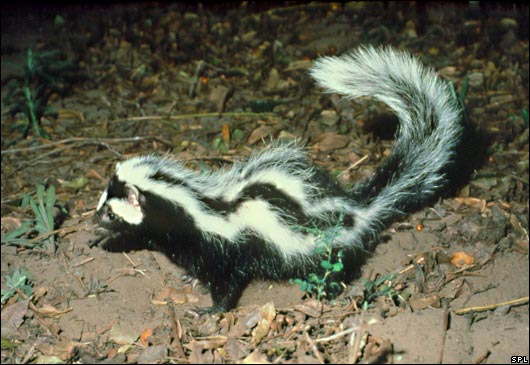|
| 질의: black back | 결과: 1007번째/1141 | |
Zorilla, Striped Polecat (Ictonyx striatus) - Wiki
| 제목: | Zorilla, Striped Polecat (Ictonyx striatus) - Wiki
| |

| 해상도: 530x365
파일크기: 53332 Bytes
등록시간: 2007:10:23 10:58:31
|
Striped Polecat
From Wikipedia, the free encyclopedia
[Photo] The zorilla (Ictonyx striatus) is a nocturnal predator that inhabits scrub, forest and grassland in southern and eastern Africa. Also known as a striped polecat, it can, when threatened, spray an irritant from glands near its anus to ward off attackers. Source: http://news.bbc.co.uk/1/shared/spl/hi/pop_ups/07/sci_nat_enl_1178711793/html/1.stm
The Striped Polecat (Ictonyx striatus, also called the African Polecat, Zoril, Zorille or Zorilla) is a member of the Mustelidae family (weasels) which somewhat resembles a skunk. It is the only member of genus Ictonyx. It is found in savannahs and open country in southern and west Africa.
Like other polecats, this carnivore is nocturnal. It has several means of avoiding predators - including the ability to emit foul-smelling excretions from its anal glands, playing dead and climbing trees. The animal is mainly black but has four prominent white stripes running from the head, along the back to the tail. The Striped Polecat is typically 60 centimeters long including a 20-centimeter tail. It lives for up to 15 years.
The Striped Polecat is solitary, tolerating contact with others only to mate. Young are generally born between September and December, with one to three young per litter.
http://en.wikipedia.org/wiki/Striped_Polecat
| The text in this page is based on the copyrighted Wikipedia article shown in above URL. It is used under the GNU Free Documentation License. You may redistribute it, verbatim or modified, providing that you comply with the terms of the GFDL. |
|
^o^
동물그림창고 똑똑전화 누리집
^o^
|
|